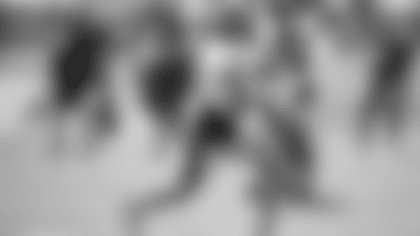Q. Following the loss to the Colts, you talked about missed opportunities for takeaways, including the inability to cover a fumble. When the ball is loose, how are players supposed to go about recovering that fumble? Is there a procedure, or is it a free-for-all?
A. Certainly, there's a technical component to it, but it's an intensity in-play and a hustler's mentality regarding finish that best positions you to finish those things. You're going to the ball. You got a bunch of people going to the ball and playing hard. It just gets you in the posture to seize those unexpected opportunities. The technical component of it is whether it's a close-quarters ball that's on the ground or an open-grass ball that's on the ground, where you get an opportunity to advance it. In terms of the judgment, we pay respect to that in a practice setting by scooping incomplete passes in 7-on-7 and things of that nature. That always creates an opportunity around space. That's how you train people to make those decisions. And so oftentimes in team development, if you see defensive backs and linebackers scooping up incomplete passes, that's what that's paying respect to. We're working on the judgment associated with scooping and advancing the ball in open grass. In close quarters, you've got to jump on that football.
Q. So what's going on in the bottom of that pile?
A. (Laughs) A lot. A lot. But like a lot of components of the game, probably not as much as used to go on in that pile. For instance in today's game, you can get a 15-yard penalty for pulling somebody out of that pile as a player. In years past, a 3-man scrum would turn into a 12-man scrum as people came in there pulling the legs of opponents and so forth, trying to get them out of the pile for clarity.
Q. After the game in Indianapolis, the first question posed to Justin Fields during his media session had to do with the botched shotgun snap late in the fourth quarter. He immediately took the blame, instead of trying to dodge the question. Is it unusual for a young guy competing for playing time to point the finger at himself like that?
A. It probably is, but Justin is new to us but not new to the position. He ascended very fast in this game as a professional and wore the responsibility of being a franchise guy for the Chicago Bears. And so although he is relatively young, he's 25 years old, he's worn that responsibility in another city, and so it probably gives him a little bit of experience beyond his years in that regard.
Q. Did you like that the way that he handled that?
A. I did, but I also expect it. And it can be both. I can appreciate it, but I also expect it.
Q. In the first half of the game in Indianapolis, after you fell behind, 14-0, there was a sequence where you chose to go for it on a fourth-and-1 from your 39-yard line, and then 3 plays later you challenged a 6-yard completion for a first down. Would it be accurate to point to those 2 things as you trying to maybe light a fire and change the course of the game?
A. Absolutely, particularly in the first half, where challenges and loss of timeouts are less significant in terms of how a game might unfold. That 6-yard catch was a possession down. And so what we're talking about there is if that gets deemed incomplete – and oftentimes you're in a visiting venue, and you don't get a look at it on the Jumbotron, and they're working at pace. It was a heavy enough moment, based on the circumstances of being 14 points down to ensure that play was what it was.
Q. You often talk about giving the team what it needs at a particular time. Did you sense that's what the team needed?
A. No question. A spark, a little flow to go along with the ebb. It came soon thereafter in the form of that run-after-catch by Darnell Washington in the flat where he stiff-armed that first would-be tackler and then hurdled the next one. Oftentimes a collective, whether it's a unit or a team, needs something to turn the tide, and I think it was that play. Sometimes it can come from a strategic component of the game – coaching decisions, aggression, etc. Although my attempts weren't successful, I thought that swing came soon thereafter, in the form of Darnell Washington's efforts.
Q. Vince Lombardi's philosophy for running the football was what he called "running to daylight," which meant look for the hole wherever it might be. When Bill Cowher was the coach here, Jerome Bettis said the back was supposed to run to the spot where the play was called and to trust the blocking. Do you have a philosophy for running the ball?
A. I do, and I don't know how interesting it might be to the listeners, but when you're facing a single-high defense, essentially all gaps are occupied from a numbers perspective, and so if all gaps are occupied, I'm interested in the DB-occupied gaps. If you're committed to running the football and you're running into a run-structured defense, the most advantageous occupied gaps to run into are those occupied by defensive backs, safeties, corners, etc. And so that's why I do "team run" in training camp, as opposed to 9-on-7. That's a philosophy of mine that I want to run the ball in DB-occupied gaps, and so the flip-side of that is, as a defensive coach, I better prepare my defensive backs to be challenged in the run game. And so that's why we do team run. Run is an 11-on-11 drill for us in team development, as opposed to a 9-on-7. And really it just pays respect to that outlook on the run concepts. You want to see how a pile falls forward appropriately for the offense, then pour the ball into a DB-occupied gap, and that pile usually falls the way that the offense wants it. You run that ball into a D-line-occupied gap or a linebacker-occupied gap, sometimes the pile doesn't necessarily fall the desired direction. And it's minute, but it's the difference between efficient running and not. A 2-yard gain vs. a 4-yard gain oftentimes is really just defined by which direction the pile falls.
Q. In hostile environments, how does crowd noise impact the running game?
A. When you're working on a silent count, there's a lack of crispness in terms of your get-off on the snap of the ball. It's somewhat (scattered). Usually the guys closer to the ball are more in line with the snap, and the further you're away from the ball the more time it takes you to respond. Now to the naked eye, it's milliseconds, but to the coordination of a running game it's significant. When you can work on cadence and get off in unison, it is an advantage. Oftentimes, when you're running the ball in a hostile environment like that, you're trying to catch the snap of the ball out of the corner of your eye, and so you don't have an advantage on the defense. The defense is ball-keying for movement. The offensive guys are ball-keying for movement when you're working on a silent count. And so generally, that nullifies any advantage in terms of beating people to the punch.
Q. How would you evaluate Najee Harris' performance through the first 4 games of this season?
A. I've been pleased with the trajectory of his game. He started faster this year than he has in other years, but he came into camp really ready to go. He was in top-notch condition. He's at that point in his career where he's still young, but yet experienced, and so it's reasonable to expect him to start with fluidity and be productive. And so I like where we are. Obviously, there's still some growth ahead of us, for him and for the collective particularly as it pertains to the run game, but I like where he is.
Q. It seems that when Najee is in the game, opposing teams' linebackers and safeties are attacking the line of scrimmage more than when your other backs are on the field. Is that an accurate observation?
A. No question. That's why everybody loves the supplementary runner. We're playing Dallas today. For example, when Ezekiel Elliott was the featured runner, and Tony Pollard was the auxiliary runner, everybody loved the auxiliary runner. The primary ballcarrier gets attention in a certain way. There's nothing sexy about their jobs. Oftentimes the auxiliary runner just simply by concept, by circumstances of the game like second-and-10 draw plays, have more running lanes. The nuts and bolts primary runner, that's a dirty job at times, and because we're playing Dallas today, a few years ago when they had Ezekiel Elliott and Tony Pollard, everybody was really attracted to Tony Pollard, to his yards per carry. It's kind of like the backup quarterback. Everybody loves the backup quarterback. Everybody loves the auxiliary runner, but the attention that they get and the circumstances in which they run are often different than the primary ballcarrier.
Q. Maybe you can help me with this. When it comes to an offensive lineman going against a pass-rusher – what constitutes holding?
A. Restriction. And I say that because those are the words, the tipping points, for the officials. Certainly, there's elements of holding on just about every snap in a football game, but it's about material restriction. That's the term that's critical in the rule book. That's the guideline from an officiating perspective. When he sees holding and it is restrictive in terms of the defensive player being productive, that's when they're triggered to throw penalty flags. And so the material restriction component of it is really big. And that's why tackles or tight ends in the running game on perimeter runs are really subject to it, because of the clarity of those moments. When the ball bounces outside of the end man on the line, or when the quarterback escapes outside of the pocket and exits to his right or left, those people often on the perimeter, from a blocking perspective, the visibility of restriction is very clear, particularly in terms of the positioning of the officials. There's usually nobody in between them and the official as it pertains to the block, and they can see material restriction. And that's why oftentimes you see penalties called on tackles when people escape, or on tight ends or on receivers on perimeter runs.
Q. So besides the obvious, the grabbing of a jersey and pulling it, what kind of things indicate restriction?
A. Oftentimes, when a defender spins off a block, as opposed to disengaging off a block, when they spin off a block, that's an indication of restriction, or someone holding them. When you see a flailing of the arms of a defender, oftentimes it's an indication of restriction, because it's just a natural human reaction to restriction of movement. And so there are some clues regarding restriction. But because I have spent a lot of time in committee, those officials are not instructed to respond to those clues. They're instructed to respond to what they see. Oftentimes, those clues are confirmation of what they see.
Q. You always say that injuries are a part of the game, and you believe in the next-man-up philosophy. But do you have to deal with in-game injuries differently than you would when you lose a guy and you have a week to prepare the next man up?
A. No question. Oftentimes, when injuries occur is what dictates the response. Sometimes an intelligent guy is an in-game backup because he can learn without physical repetition. But given an opportunity over a week to prepare, you might view someone else as a better option. And so the decision-making about who plays for the injured guy, oftentimes is predicated on when the injuries occur. Some people are better in-game and working on a limited amount of reps, but you might give another guy a full week to prepare and his floor might be higher. And so there's a lot of layers to the discussion. But make no mistake, there's a significant difference between in-game adjustments and the 6-or-7 day cycle associated with a week's prep.
Q. So you spend a whole week formulating a plan and then you practice the plan. Then you have an in-game injury. What happens to the plan?
A. There's an adjustment. And I'll list a couple specific instances to give you an example of it. Last week, James Daniels got hurt in the first quarter of the game. It put Spencer Anderson into the game. And so when we went for the fourth-and-1, Ryan McCollum was playing the extra tight end position as opposed to Spencer Anderson. Spencer Anderson got all the extra tight end work during the course of the week. Guess what happened on the fourth-and-1? Ryan McCullum missed his block, and that was a critical reason why we didn't convert it. And so there's an example of an in-game injury affecting the outcome of a situational play because of the evolution of auxiliary pieces. What I'm talking about is Spencer Anderson was an extra tight end for short yardage circumstances. He moved in and played right guard, and so our auxiliary position backup got elevated, and he got put in the game in a weighty moment, a fourth-and-1. And so that's just the challenge of preparing a group, individually and collectively for a game when there's the unforeseen involved. Last week, we were getting ready to play Colts quarterback Anthony Richardson. He has a certain skill-set, including quarterback mobility, etc. He gets hurt in the game, and in comes Joe Flacco. That is a different set of circumstances. I was prepared (for Flacco) as a coach. We were prepared as coaches, but I didn't water down last week's preparation with a bunch of physical repetition to defend Joe Flacco. And so we had a Joe Flacco menu, but it wasn't necessarily the menu executed by our defensive players during preparation for the game. And so there's a lot of layers to in-game injuries, and those are just a couple examples of it.
Q. You worked with Dick LeBeau for a lot of years, and his signature as a defensive coordinator was the zone-blitz. Mike Zimmer is another of those long-time, venerable defensive coordinators. Does he have a signature defensive scheme?
A. He's the godfather of what we refer to as "ammo" or double-A-gap pressures. He's one of the first guys to do it consistently on possession downs. When you see the linebackers walked up in the A-gap on third down, that's what we refer to as double-As. They do a lot of things out of it. They rush four out of it. They bring a variety of blitzes out of it. But what its emphasis is, is to put the offense in a protective posture, to limit the amount of eligibles that the defense has to cover on a possession down. The defense puts both linebackers walked-up in that A-gap, then most of the time they don't have to worry about that running back as a pass receiver. And sometimes it even affects the tight end. And so in third down circumstances, it's much easier, obviously, to defend three eligibles running upfield than five eligibles. It is a posture oftentimes utilized to put the offense in a turtle-like shell and minimize the number of eligibles going out into the pattern. And the more people you put out into the pattern as an offense, the more prepared you need to be for the myriad of things that Zimmer can do out of that structure. And so we've been going against Zim for a long time. He was a defensive coordinator in Cincinnati from 2008-13, and even when he left, his successor in Cincinnati – Paul Guenther – did the same things. And as we prepared this week, guess who we were preparing for? Zimmer, and one of his chief assistants on the defensive side of the ball in Dallas is Paul Guenther, the guy who replaced him in Cincinnati. And so none of this is new to us, and by us I mean guys like me from a coaching perspective. But a guy like Zach Frazier was in middle school when all of that was going on, and so there's a learning process.













